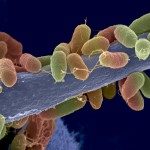Link to Pubmed [PMID] – 29371495
J Fungi (Basel) 2017 Dec;4(1)
produce airborne spores (conidia), which are inhaled in abundant quantity. In an immunocompromised population, the host immune system fails to clear the inhaled conidia, which then germinate and invade, leading to pulmonary aspergillosis. In an immunocompetent population, the inhaled conidia are efficiently cleared by the host immune system. Soluble mediators of the innate immunity, that involve the complement system, acute-phase proteins, antimicrobial peptides and cytokines, are often considered to play a complementary role in the defense of the fungal pathogen. In fact, the soluble mediators are essential in achieving an efficient clearance of the dormant conidia, which is the morphotype of the fungus upon inhalation by the host. Importantly, harnessing the host soluble mediators challenges the immunological inertness of the dormant conidia due to the presence of the rodlet and melanin layers. In the review, we summarized the major soluble mediators in the lung that are involved in the recognition of the dormant conidia. This knowledge is essential in the complete understanding of the immune defense against .
